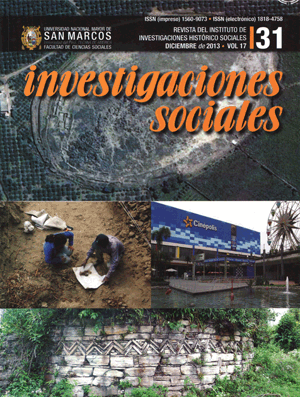shambar: ancient food for farm laborers (department of la libertad)
DOI:
https://doi.org/10.15381/is.v17i31.7911Keywords:
Shambar, food, laborers, wheat.Abstract
The research deals with the study of an ancient stew called Shambar, created for food laborers who worked inside the highland haciendas in the provinces of Santiago de Chuco and Jose Faustino Sanchez Carrion in the Department of La Libertad, spreading its influence to the provinces Cajabamba (Cajamarca) and Pallasca (Ancash). Consolidated Andes hacienda regime, were installed inside new crops imported by the colonial system. After a successful temporal experience in the cultivation of cereals on the coast as a result of climate change (1780), which was wet unsuitable for growing wheat, the cereal up to the Andes Yungas settling in areas characterized by dry and warm. The highland haciendas of La Libertad and other estates formed in our territory where large workforce needed to meet the tasks of cultivation and production of various products, this «peons» in order not to distract their work and take advantage of the maximum that lasts a day, needed to be fed at noon on the same stage where they do the work, or the farm. This food besides being cheap and easy to prepare, put on the plate should be generous in tsheir abundance also quick and easy distribution to all diners pawns. Possibly by the combination of these features, in addition to being tasty and nutritious dish, shambar managed to stay in time, mobilized from its territory of origin, passing and stopping with aplomb in urban areas within the region, then, along with the migration of a segment of the population starting around the 50s of last century, down to the coast, taking possession safely in funds picanterias small restaurants of the city of Trujillo.Downloads
Published
Issue
Section
License
Copyright (c) 2013 Simón Escamilo Cárdenas

This work is licensed under a Creative Commons Attribution-NonCommercial-ShareAlike 4.0 International License.
AUTHORS RETAIN THEIR RIGHTS:
a. Authors retain their trade mark rights and patent, and also on any process or procedure described in the article.
b. Authors retain their right to share, copy, distribute, perform and publicly communicate their article (eg, to place their article in an institutional repository or publish it in a book), with an acknowledgment of its initial publication in Investigaciones Sociales.
c. Authors retain theirs right to make a subsequent publication of their work, to use the article or any part thereof (eg a compilation of his papers, lecture notes, thesis, or a book), always indicating the source of publication (the originator of the work, journal, volume, number and date).






